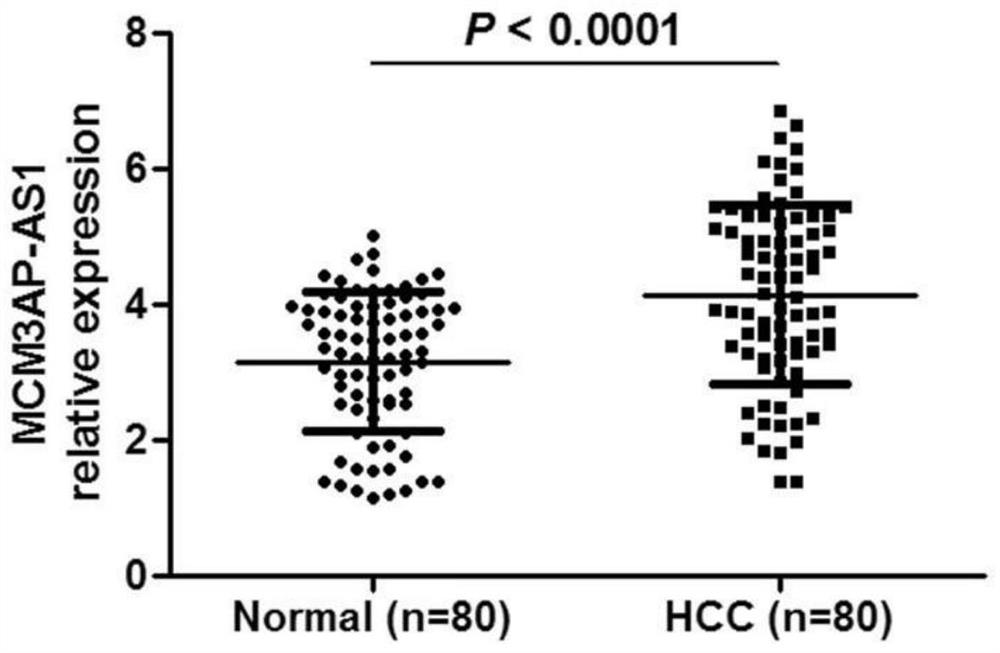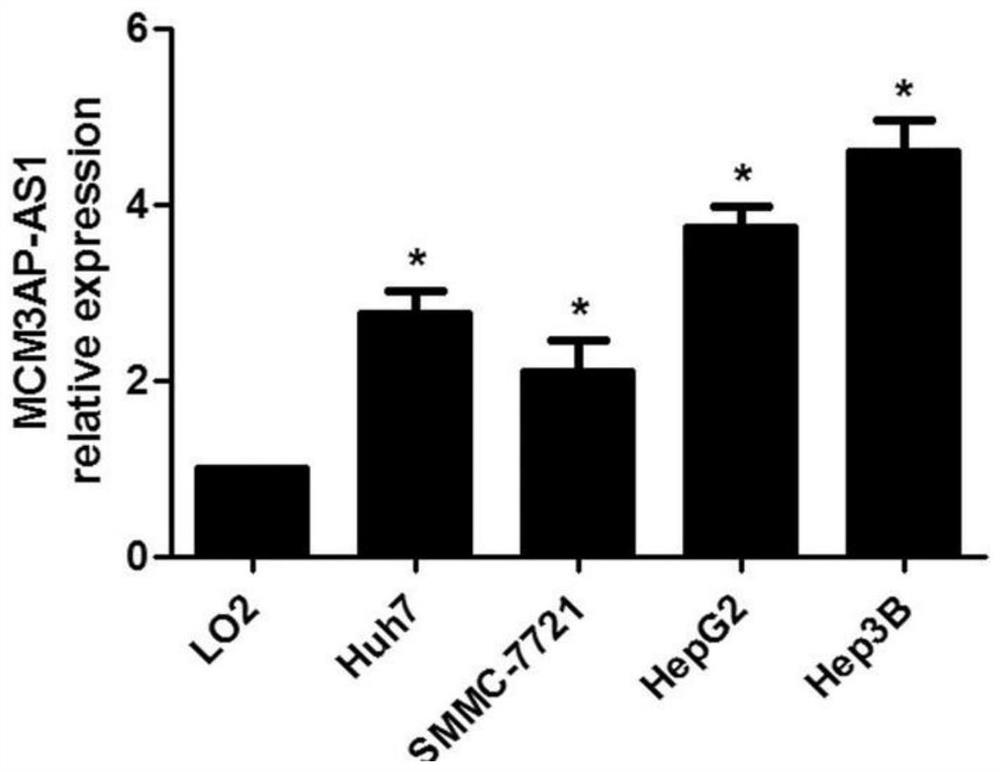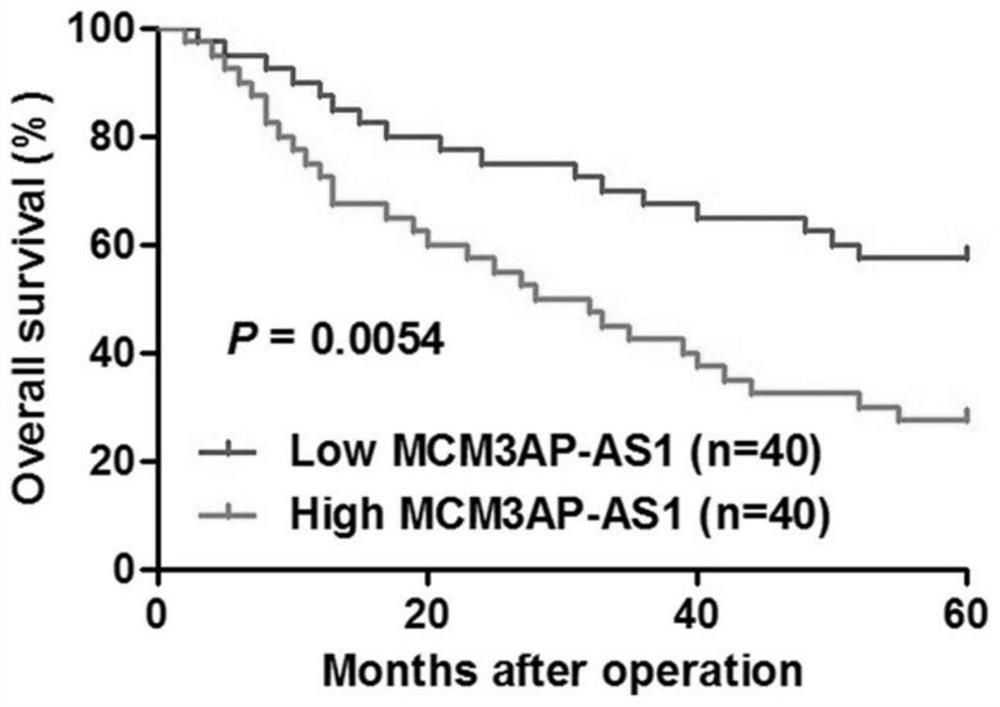Long-chain non-coding RNA and application thereof in diagnosis and treatment of hepatocellular carcinoma
A long-chain non-coding, hepatocellular carcinoma technology, applied in the treatment of hepatocellular carcinoma, long-chain non-coding RNA and its application in the field of diagnosis
- Summary
- Abstract
- Description
- Claims
- Application Information
AI Technical Summary
Problems solved by technology
Method used
Image
Examples
Embodiment 1
[0045] This example provides verification of the expression and prognosis of lncRNA MCM3AP-AS1 in HCC.
[0046] 1. Experimental materials and methods
[0047] 1.1 Clinical specimens
[0048] A total of 80 pairs of HCC and paracancerous tissues were collected from patients undergoing hepatectomy. Sample collection criteria were as follows: ① confirmed as HCC by two pathologists; ② did not receive any preoperative treatment; ③ not associated with other cancers. All samples were washed with pre-cooled PBS and immediately frozen in liquid nitrogen and stored in a -80°C refrigerator. 80 patients were followed up to collect survival data.
[0049] 1.2 Cell lines and culture
[0050] Immortalized human normal liver cells LO2 and HCC cell lines (Hep3B, HepG2, Huh7, SMMC-7721) were purchased from Shanghai Institutes for Biological Sciences, Chinese Academy of Sciences (Shanghai, China). Hep3B was cultured in MEM medium (Hyclone, USA), and LO2, HepG2, Huh7, SMMC-7721 were cultured ...
Embodiment 2
[0069] This example discusses the effect of interfering lncRNA MCM3AP-AS1 on the biological function of HCC cells (Hep3B, HepG2).
[0070] 1. Experimental materials and methods
[0071] 1.1 Cell lines and culture
[0072] Same as Example 1
[0073] 1.2 RNA fluorescence in situ hybridization (Fluorescence in situ hybridization, FISH)
[0074] Cy3-labeled lncRNA MCM3AP-AS1 probe and subcellular localization detection kit were purchased from Ribo (Guangzhou, China), and observed using a confocal laser microscope (Carl Zeiss, Oberkochen, Germany).
[0075] 1.3 Cell Transfection
[0076] Two specific lentivirus-mediated shRNAs (sh-MCM3AP-AS1-1 and sh-MCM3AP-AS1-2) targeting lncRNA MCM3AP-AS1 and the negative control sh-control were designed and synthesized by Jisai Biotech (Guangzhou, China) , and the interference sequences are SEQUENCE NO.4 and SEQUENCE NO.5, respectively. Lentivirus infection of HCC cells was carried out with the transfer promoter Polybrene (8ng / ml).
[007...
Embodiment 3
[0095] 1. Experimental materials and methods
[0096] 1.1 Cell lines and culture
[0097] Same as Example 1
[0098] 1.2 Tumor xenograft model
[0099] 4-5 weeks old, 18-20 g, BALB / C male nude mice (Slack, Shanghai, China) were selected and randomly divided into two groups (n=6 in each group). Hep3B cells transfected with sh-MCM3AP-AS1 and sh-control (1×10 6 ) into the right flank of mice by subcutaneous injection. Tumor volume was measured every three days after tumor formation. Volume calculation formula: volume=(length×width×width) / 2. After 3 weeks, all mice were sacrificed under anesthesia.
[0100] 1.3 Data statistics and analysis
[0101] Same as Example 1
[0102] 2. Experimental results
[0103] 2.1 In Example 3, the present invention established a tumor xenograft model in nude mice by subcutaneously injecting Hep3B cells transfected with sh-MCM3AP-AS1 and sh-control. The results of this in vivo experiment show that knocking down lncRNA MCM3AP-AS1 can inhibit ...
PUM
 Login to View More
Login to View More Abstract
Description
Claims
Application Information
 Login to View More
Login to View More - R&D
- Intellectual Property
- Life Sciences
- Materials
- Tech Scout
- Unparalleled Data Quality
- Higher Quality Content
- 60% Fewer Hallucinations
Browse by: Latest US Patents, China's latest patents, Technical Efficacy Thesaurus, Application Domain, Technology Topic, Popular Technical Reports.
© 2025 PatSnap. All rights reserved.Legal|Privacy policy|Modern Slavery Act Transparency Statement|Sitemap|About US| Contact US: help@patsnap.com



